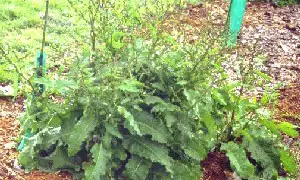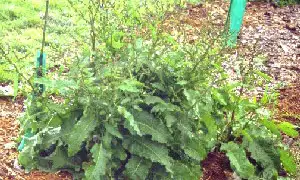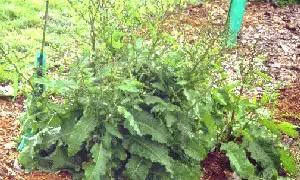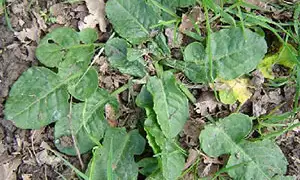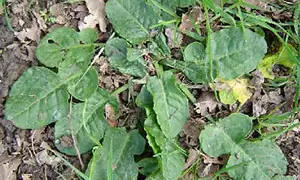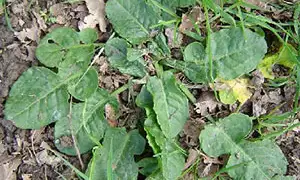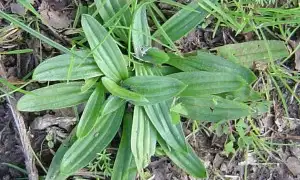Botanical name: Rumex conglomeratus
Family name: Polygonaceae
Overview

Clustered dock.
There are a number of different dock species that grow within New Zealand, with the broad-leaved dock being the most common. However, the clustered dock is also fairly common in many places throughout the country, often growing alongside the broad-leaved dock.
As with broad-leaved dock, the clustered dock is a perennial weed that has a large tap-root system. It can vary in size quite considerably, sometimes surviving in regularly mown lawns by producing small, prostrate leaves, but usually growing quite large in pastures and waste areas, out-competing surrounding plants by covering them with its large leaves.
It generally has a growing point at ground level from which it produces its leaves, but every spring it forms an upright stem on which it forms fruits that start out green, turn red and eventually become dark brown as they dry out.
The seeds produced by docks each year are long-lived, so huge banks of dock seeds can build up within the soil. When dock-infested paddocks get cultivated, the soil is soon reinfested by docks, both from seedlings and also because the tap roots are seldom killed by cultivation and so regrow.
The foliage of docks contains tannins which makes them somewhat unpalatable to some livestock, especially cattle and horses. Sheep will generally eat docks if they aren't too large or dense, but cows prefer not to eat them, so docks can become quite a problem on dairy farms.
Docks are more tolerant of poorly drained soil than many other plant species, so are commonly found in low-lying parts of paddocks.
Distinguishing features
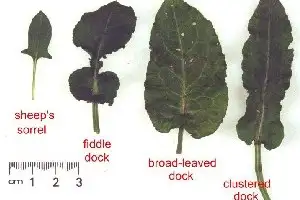
Leaf comparison between similar weeds.
The leaf shape of some of the more common rumex weeds is shown in the image above. The docks are closely related to sheep's sorrel, which also belongs to the Rumex genus. A broad-leaved dock, as suggested by its name, tends to have a wider leaf than a clustered dock. The broad-leaved dock leaf is usually wider near the base than near the tip, whereas clustered dock has less of a change in width from one end of the leaf to the other.
The fiddle dock gets its name from being shaped like a fiddle or violin, so is easier to differentiate from a broad-leaved dock. Another dock species is curled dock (Rumex crispus), which has a leaf shape similar to a clustered dock but the leaf margins are very wavy.
As with many weeds, the leaves that grow from the base of the plant are better for telling the docks apart than those up the flower stems, which aren’t always the typical shape.
The fruits of docks, once they have matured, are about 2-3 mm across and are often also used to tell dock species apart. The broad-leaved dock fruits tend to each have three "wings" with jagged edges, unlike clustered dock fruits. There are three equal-sized inflated "bladders" on the fruits of a clustered dock, whereas the broad-leaved dock has one large bladder and two smaller ones for each fruit. The curled dock has fruits with three large wings that aren't jagged.
Control
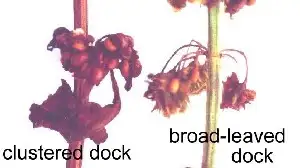
Comparison of fruit produced by dock weeds.
Docks as a group are quite difficult to kill. They have a moderate tolerance to most herbicides, and glyphosate needs to be applied at a fairly high rate when controlling docks in waste areas or when spraying out pastures during seed-bed preparation. It is best not to apply glyphosate while the plant has a seed head.
For selective control of docks in pastures, hormone herbicides such as 2,4-D and MCPA are ineffective at controlling established plants. For many years, the standard recommendation in pastures has been to apply asulam (Asulox or Dockstar).
Another treatment has since become available, namely thifensulfuron (Harmony), which tends to be cheaper than asulam. Both herbicides should be applied in spring while docks are actively growing but before seed head formation has begun. Both of them will cause temporary suppression of pasture growth after application, and both may require a follow-up application for well-established dock plants.
Another possibility is to spot-spray in pastures with aminopyralid (T-Max). In turf, a triclopyr/picloram mix (Victory Gold) will give good control. In orchards, either use asulam to spot-spray docks or add fluroxypyr (Tandus XL) to glyphosate to improve the control of the glyphosate.
In farming systems with sheep, it can simply be grazed out with sheep. In dairy farms, tight rotational grazing can stop it from dominating, as cows will eat docks, though more at some times of the year than others. Break-feeding during winter generally results in docks being grazed quite well. Topping (mowing) paddocks in summer after grazing can knock back flowering plants that have been avoided by cows.
